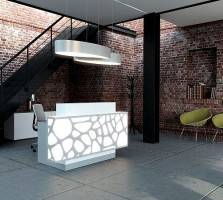 Described as ‘key to growth in the sector’ by chief construction adviser, Peter Hansford and increasingly recognised as a much more collaborative and efficient way of working, Building Information Modelling (BIM) continues to gather supporters from across the industry, yet there is a percentage of people who are still keeping their heads down and hoping it will all just go away. Maybe it’s the required element of investment or maybe it’s the small matter of change itself – always a difficult one for the construction industry – but there is still an amount of SMEs who are shrinking away from BIM, despite the fact that it is destined to become the established way.
Described as ‘key to growth in the sector’ by chief construction adviser, Peter Hansford and increasingly recognised as a much more collaborative and efficient way of working, Building Information Modelling (BIM) continues to gather supporters from across the industry, yet there is a percentage of people who are still keeping their heads down and hoping it will all just go away. Maybe it’s the required element of investment or maybe it’s the small matter of change itself – always a difficult one for the construction industry – but there is still an amount of SMEs who are shrinking away from BIM, despite the fact that it is destined to become the established way.
The idea that architectural standards of communication have changed and will continue to do so is hard for many to embrace – particularly traditionally-minded professionals – and, there is no doubt, a certain amount of funding is involved. For instance, in order for a company to fully embrace it as best practice, BIM needs to be fully integrated with working practices, with adequate investments made in ICT, including broadband provision, data management, 3D printing and software functionality.
The flip side is, it should win business for the contractor and the supplier, as more and more companies are demanding it. It should also save money as a more unified way of working means less misunderstandings and so less to put right. The training involved means that members of staff are being invested in too – which is always a good thing.
With the Government driving BIM through on public sector projects, the private sector has to follow at some point. It’s inevitable. Most large private sector companies will be doing it within the next twelve months – they’ve been left with little choice as blue chip clients are now demanding it of their supply chains – and there will be a trickle down effect when it comes to the SMEs.
Fact is, BIM is there to be embraced by all communities within the construction sector and that alone makes it no bad thing. Improving information quality makes outcomes more predictable and it makes sense that tighter collaboration and information flow provides the basis for a new level of best practice. For BIM is so much more than just a detailed 3D model of a building. The accuracy of the model, combined with animations and fly-throughs, allows contractors to access the design lay-out before the build takes place and make alterations accordingly.
One of the key concepts behind BIM is that everything is connected so if you move a wall, the elements attached to the wall on the model will also move. Similarly, if you change the volume of a floor, the quantities of material needed will automatically alter. The sharing of this critical information through a single model that adapts as it changes means that all organisations share the changes so that they don’t have to be made multiple times leaving more room for error.
Could this stifle creativity and flatten good design? With any software, there’s always an element of that as impulses for changes and margins for error are removed to a degree but it’s how you work with that software that matters. A good office designer will not be constricted by it but use it as a tool to work more effectively and efficiently. And, of course, the over-riding benefit is that, when the build happens, there will be fewer errors and far less rework needed.
For manufacturers, there is a long way still to go but a good start for office furniture providers would be to have their products included in a ‘BIM library’. Designers and architects can drop their products into a 3D model at the beginning of a project, giving specific manufacturers more opportunity to be selected early as a supplier. Of course, there is a cost for the furniture supplier to become BIM compliant, getting products into a BIM library etc, but the return on investment makes it worth it – early exposure and huge potential to be aligned with major projects in both the public and private sector.
In a couple of years, this will all be the norm anyway. The major point is that we should not be fearful of this change but embrace it as not to do so could ultimately cost and will hamper new business opportunities and further growth. At the moment, to adopt BIM gives any SME the advantage but soon it won’t be up for debate – Best for all concerned to save time and money and take it on board now.
______________________________
 Michael Page is the Joint Managing Director of Saracen Interiors. www.saraceninteriors.com
Michael Page is the Joint Managing Director of Saracen Interiors. www.saraceninteriors.com













January 8, 2015
We all need to embrace the opportunities presented by BIM
by Michael Page • Architecture, Comment, Technology, Workplace design
The idea that architectural standards of communication have changed and will continue to do so is hard for many to embrace – particularly traditionally-minded professionals – and, there is no doubt, a certain amount of funding is involved. For instance, in order for a company to fully embrace it as best practice, BIM needs to be fully integrated with working practices, with adequate investments made in ICT, including broadband provision, data management, 3D printing and software functionality.
The flip side is, it should win business for the contractor and the supplier, as more and more companies are demanding it. It should also save money as a more unified way of working means less misunderstandings and so less to put right. The training involved means that members of staff are being invested in too – which is always a good thing.
With the Government driving BIM through on public sector projects, the private sector has to follow at some point. It’s inevitable. Most large private sector companies will be doing it within the next twelve months – they’ve been left with little choice as blue chip clients are now demanding it of their supply chains – and there will be a trickle down effect when it comes to the SMEs.
Fact is, BIM is there to be embraced by all communities within the construction sector and that alone makes it no bad thing. Improving information quality makes outcomes more predictable and it makes sense that tighter collaboration and information flow provides the basis for a new level of best practice. For BIM is so much more than just a detailed 3D model of a building. The accuracy of the model, combined with animations and fly-throughs, allows contractors to access the design lay-out before the build takes place and make alterations accordingly.
One of the key concepts behind BIM is that everything is connected so if you move a wall, the elements attached to the wall on the model will also move. Similarly, if you change the volume of a floor, the quantities of material needed will automatically alter. The sharing of this critical information through a single model that adapts as it changes means that all organisations share the changes so that they don’t have to be made multiple times leaving more room for error.
Could this stifle creativity and flatten good design? With any software, there’s always an element of that as impulses for changes and margins for error are removed to a degree but it’s how you work with that software that matters. A good office designer will not be constricted by it but use it as a tool to work more effectively and efficiently. And, of course, the over-riding benefit is that, when the build happens, there will be fewer errors and far less rework needed.
For manufacturers, there is a long way still to go but a good start for office furniture providers would be to have their products included in a ‘BIM library’. Designers and architects can drop their products into a 3D model at the beginning of a project, giving specific manufacturers more opportunity to be selected early as a supplier. Of course, there is a cost for the furniture supplier to become BIM compliant, getting products into a BIM library etc, but the return on investment makes it worth it – early exposure and huge potential to be aligned with major projects in both the public and private sector.
In a couple of years, this will all be the norm anyway. The major point is that we should not be fearful of this change but embrace it as not to do so could ultimately cost and will hamper new business opportunities and further growth. At the moment, to adopt BIM gives any SME the advantage but soon it won’t be up for debate – Best for all concerned to save time and money and take it on board now.
______________________________